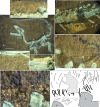Exceptionally preserved juvenile megalosauroid theropod dinosaur with filamentous integument from the Late Jurassic of Germany
- PMID: 22753486
- PMCID: PMC3406838
- DOI: 10.1073/pnas.1203238109
Exceptionally preserved juvenile megalosauroid theropod dinosaur with filamentous integument from the Late Jurassic of Germany
Abstract
Recent discoveries in Asia have greatly increased our understanding of the evolution of dinosaurs' integumentary structures, revealing a previously unexpected diversity of "protofeathers" and feathers. However, all theropod dinosaurs with preserved feathers reported so far are coelurosaurs. Evidence for filaments or feathers in noncoelurosaurian theropods is circumstantial and debated. Here we report an exceptionally preserved skeleton of a juvenile megalosauroid, Sciurumimus albersdoerferi n. gen., n. sp., from the Late Jurassic of Germany, which preserves a filamentous plumage at the tail base and on parts of the body. These structures are identical to the type 1 feathers that have been reported in some ornithischians, the basal tyrannosaur Dilong, the basal therizinosauroid Beipiaosaurus, and, probably, in the basal coelurosaur Sinosauropteryx. Sciurumimus albersdoerferi represents the phylogenetically most basal theropod that preserves direct evidence for feathers and helps close the gap between feathers reported in coelurosaurian theropods and filaments in ornithischian dinosaurs, further supporting the homology of these structures. The specimen of Sciurumimus is the most complete megalosauroid yet discovered and helps clarify significant anatomical details of this important basal theropod clade, such as the complete absence of the fourth digit of the manus. The dentition of this probably early-posthatchling individual is markedly similar to that of basal coelurosaurian theropods, indicating that coelurosaur occurrences based on isolated teeth should be used with caution.
Conflict of interest statement
The authors declare no conflict of interest.
Figures




References
-
- Wellnhofer P. 2008. Archaeopteryx. Der Urvogel von Solnhofen [Archaeopteryx. The primary bird from Solnhofen] (Dr. Friedrich Pfeil, Munich). [in German]
-
- Xu X, Guo Y. The origin and early evolution of feathers: insights from recent paleontological and neontological data. Vert PalAs. 2009;47:311–329.
-
- Mayr G, Peters DS, Plodowski G, Vogel O. Bristle-like integumentary structures at the tail of the horned dinosaur Psittacosaurus. Naturwissenschaften. 2002;89:361–365. - PubMed
-
- Zheng XT, You HL, Xu X, Dong ZM. An Early Cretaceous heterodontosaurid dinosaur with filamentous integumentary structures. Nature. 2009;458:333–336. - PubMed
-
- Unwin DM. The Pterosaurs from Deep Time. New York: Pi; 2005.
Publication types
MeSH terms
LinkOut - more resources
Full Text Sources
Molecular Biology Databases
Miscellaneous

